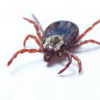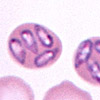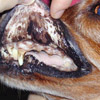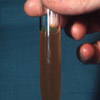 |
||||||
| |
Home | About Us
|
Services |
Products |
Pet Identification |
Pet Health Insurance | | Breeder News | News | Articles | Tick & Flea Control | Dog Training | Dental Health | | Cat & Dog Vaccinations | Cat & Dog Sterilisations | | Chew on This Newsletter | Links | |
||||||
|
Biliary Fever (Canine Babesiosis) / Bosluiskoors
(Tick Fever) |
||||||
|
Biliary is a very common disease in the
South Coast area accounting for a large percentage of cases
presented to Vet Hospital Port Shepstone each year. Although it
may be catastrophic it is also easily treated in the early
stages and can be prevented with proper tick control. Biliary fever is caused by the parasite (Babesia canis) which is carried by some ticks. The ticks that mainly prey on dogs are the Yellow dog tick (Haemophysalis leachi) and the Kennel tick (Rhipicephalus sanguineus) and infected ticks can transmit the disease. The parasite infects a dog by means of a tick bite and enters the blood stream through the tick’s saliva. The parasite then penetrates the red blood cells of the dog. Signs of disease will become apparent from 7-21 days after infection. Symptoms of the disease are caused by a generalized inflammation and anaemia (blood loss) and can range from mild to fatal. It is important to note that not all ticks transmit the disease, i.e. not all ticks are carriers of the parasite. Only after a tick ingests blood from an infected dog the parasite can transferred to another dog. Also note that you only need one infected tick bite to transmit the disease. Not all infected dogs are tick riddled! The parasite causes a reaction in the body and the bodies’ defence mechanisms act to try to eradicate the parasite from the blood stream. This causes the fever and some of the complications. The parasite also directly causes the red blood cells to rupture and this could cause the urine to become red, if excessive amounts are damaged. The anaemia caused by biliary can be very severe. Complications which can occur due to the infection include: Renal failure, acute respiratory distress syndrome (fluid on the lungs), blood clotting abnormalities, liver damage and brain damage. These patients usually require intensive medical care and carry a poorer prognosis for recovery. Killing the parasite, giving a blood transfusion (if the anaemia is severe) and medically managing the complications and symptoms which may be evident, manage the disease. Early symptoms of infection are lethargy (weakness), anorexia (inappitence) and pale gums with a fever. Other symptoms like depression, vomition, dehydration and nervous signs are also possible. The diagnosis is quickly made by an experienced veterinarian on a blood smear under a microscope. Blood is preferably collected from a dog's ear. When early diagnosed, some patients can be treated with appropriate injections. Note that some of these injections can harm the patient if the dose is incorrect or if the patient does not have Babesia in the first place! Tick control is essential to prevent the disease. In the South Coast ticks are evident throughout the year. Vet Hospital Port Shepstone recommends monthly use of CERTIFECT™, an easy applicable, top spot treatment that also kills fleas.
Also see: |
||||||
 |
||||||
| © 2011 - 2013 Vet Hospital Port Shepstone - www.vet-portshepstone.co.za | ||||||




